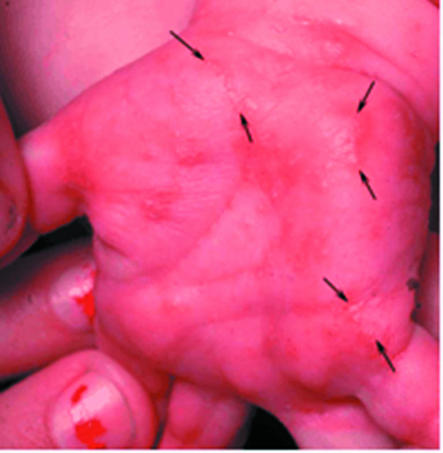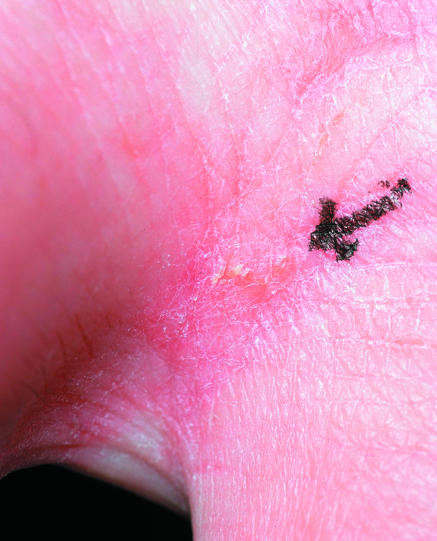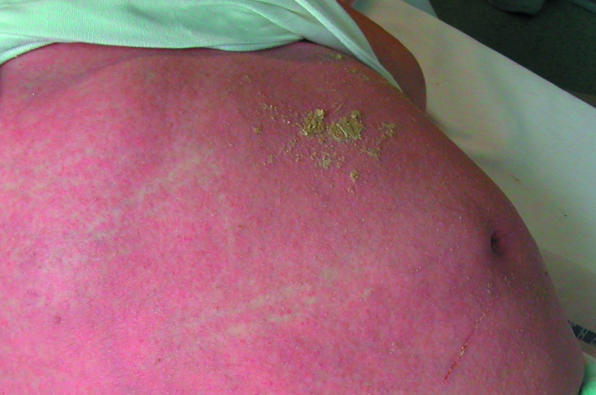Scabies is an intensely itchy dermatosis caused by the mite Sarcoptes scabiei. A patient with ordinary scabies may have an average of 12 mites; however, those with crusted scabies may have thousands of mites. The infestation occurs at all ages, but particularly in children. It is a common public health problem in poor communities and is widespread in many underdeveloped countries.
How is it spread?
Scabies is highly contagious, and person to person spread occurs via direct contact with the skin. Transfer from clothes and bedding occurs rarely and only if contaminated by infested people immediately beforehand.1
Infestation occurs when the pregnant female mite burrows into the skin and lays eggs. After two or three days, the larvae emerge and dig new burrows. They mature, mate, and repeat this cycle every two weeks.
How do I diagnose it?
A history of itching in several family members over the same period is almost pathognomonic. However, lack of a history of itching in family members does not exclude scabies. It can be notoriously difficult to get family members to admit to a history of possible scabies, and some people with scabies genuinely seem not to itch.
If left untreated, scabies can continue for many months. It is important to remember that recurrence of symptoms after attempted treatment does not exclude the diagnosis of scabies because patients may not have treated themselves correctly or may have been reinfested by an untreated contact.
What are the symptoms and signs?
The main symptoms of scabies are probably a result of the host immune reaction to the burrowed mites and their products.2 Scabies presents within two to six weeks of initial infestation, but reinfestation can provoke symptoms within 48 hours. Pruritus is the hallmark of scabies regardless of age.
Summary points
A high index of suspicion is needed to diagnose scabies correctly
Consider scabies in any adult with widespread eczema or pruritus of new onset
Incorrect or inappropriate treatment is ineffective and promotes drug resistance
Permethrin 5% dermal cream is the treatment of choice for scabies in Britain, Australia, and the United States, but it must be applied correctly
The most common presenting lesions are papules, vesicles, pustules, and nodules (fig 1). The pathognomonic sign is the burrow; a short, wavy, scaly, grey line on the skin surface (fig 2). These burrows are most easily found on the hands and feet, particularly in the finger web spaces, thenar and hypothenar eminences, and on the wrists. They are often missed if the skin has been scratched, has become secondarily infected, or if eczema is present. Eczema can either be pre-existing or can develop as a result of infestation with the scabies mite. Indeed, scabies can cause widespread eczema, probably as a result of patients' immune reaction to burrowing mites and their faecal products. This eczema can become secondarily infected with Staphylococcus, Streptococcus, or both.
Fig 1.
Childhood scabies, showing multiple pruritic papules, vesicles, and pustules. The burrows are arrowed
Fig 2.
Scabies burrow in web space between fingers
In adults, scabies is characterised by intractable pruritus, worse at night, and with lesions in the web spaces, fingers, flexor surfaces of the wrists, axillae, abdomen (around the umbilicus), lower portions of the buttocks, and genital areas.
In women itching of the nipples associated with generalised pruritic papular eruption is characteristic
In men itchy papules on the scrotum and penis are virtually pathognomonic.
In infants and young children scabies often affects the face, head, neck, scalp, palms, and soles, and there is often generalised skin involvement. In infants the commonest presenting lesions are papules and vesicopustules. Vesicopustules are particularly common on the palms and soles.
A high index of suspicion is needed to diagnose scabies correctly because of the wide range of symptoms and presentations. Furthermore, the distribution of lesions in adults (very rarely on the face and neck) and children (commonly on the face and neck) is different.
It is important to consider the diagnosis of scabies in any patient presenting with widespread eczema or pruritus of new or recent onset, or with widespread impetigo.3
Is it different in very young children?
Very young children often have widespread eczematous erythema, particularly on the trunk, which is sometimes more symptomatic than the lesions on the typical sites. Very young babies do not scratch and may just seem miserable or feed poorly. Pinkish brown scabetic nodules are particularly characteristic of scabies in babies.
How do I confirm the diagnosis?
Scabies is usually diagnosed on history and examination. Definitive diagnosis relies on microscopic identification of mites or eggs from skin scrapings of a burrow. However, treatment should be started if scabies is suspected clinically, even if it cannot be confirmed by microscopy.4
What is crusted scabies?
Crusted scabies is also known as Norwegian scabies because of its initial description in Norwegian patients with leprosy. In patients with neurological disorders or immunosuppression the number of mites can escalate rapidly. This may be due to the impaired immune response, the lack of pruritus, or the patient's physical inability to scratch. Clinically, the eruption is suspected when there is marked thickening and crusting of the skin (fig 3), particularly on the hands, although the entire body including the face and scalp is often involved.
Fig 3.
Crusted scabies with characteristic thickening and crusting of the skin
Patients with crusted scabies are a common cause of institutional outbreaks of scabies.
What about scabies in people with HIV infection?
Patients with HIV infection or AIDS are more prone to develop crusted scabies.
How common is scabies?
The prevalence of scabies in many populations rises and falls cyclically, peaking every 15-25 years, for reasons unknown. A lower prevalence of infestation has been observed in African-Americans than in other ethnic groups in the United States. Scabies is endemic in developing parts of the world, where treatment is expensive. Scabies is currently widespread in North America and Europe, with no evidence that this epidemic is abating.5
Clinical tips
Ask about family members who itch
Treat all close contacts at the same time
Itch can persist for up to six weeks after treatment
-
Diagnostic difficulty may occur when Scabies occurs in infants and young children Scabies occurs in adults or children with pre-existing eczema
There is secondary bacterial infection of the skin A patient who has been previously treated becomes reinfested
What are the risk factors?
Scabies is transmitted by close personal contact. Infants and children are therefore particularly liable to infection from close physical contact with other children and adults at home and at school. Outbreaks can occur among elderly people in nursing homes and can be transmitted to nursing staff. Transmission between adults is often by sexual contact.
How do I treat it successfully?
Successful treatment of scabies requires:
Correct diagnosis: this is the most important message of this article, as incorrect diagnosis is the main reason for patients being treated inappropriately
Elimination of the mites by means of scabicides (applied correctly)
Treatment of symptoms
Treatment of secondary infection if present.
What scabicide treatments are available?
A variety of effective topical treatments are available to treat scabies, including permethrin, benzyl benzoate, malathion, lindane, crotamiton.6 The treatment you select is determined by factors such as local epidemiology of resistance, drug toxicity, and (particularly in underdeveloped countries) cost and availability.
Which should I use?
Permethrin 5% dermal cream is the treatment of choice for scabies in the UK, Australia, and US.2 It is the most effective topical agent, is well tolerated, and has low toxicity.1,7
Malathion should be used as second choice. Children should be given aqueous preparations because alcoholic lotions sting and can cause wheeze.
Is compliance important?
To maximise treatment success, correct application of topical preparations is of cardinal importance. Permethrin should be applied twice, with applications one week apart. Treatment should be applied to the whole body (except head and neck), including web spaces of fingers and toes, the genitalia, and under the nails. In children aged up to 2 years and in elderly and immunocompromised people the application should be extended to the scalp, neck, face, and ears.
Patients should reapply treatment to their hands if they wash them during the treatment period. Mittens or socks may be necessary for the hands of thumb or toe sucking infants and toddlers.
All members of the affected household should be treated at the same time (as should the sexual contacts of adults). The application should be washed off after the recommended time (12 hours for permethrin) and clothes and bed linen machine washed at temperatures above 50°C.4
Does treatment fail?
Yes, and evidence of previous treatment should not exclude the diagnosis of scabies because patients can be reinfested by untreated contacts. Common reasons for treatment failure include
Infants removing the treatment from their hands when sucking their fingers
Adults inadvertently washing the lotion off their hands
Escaping treatment—This often happens in pregnant women, people with other skin disease, and small babies. Also, children sometimes live in more than one household and may be omitted from treatment.
Is there an oral treatment for scabies?
The oral antiparasitic drug ivermectin is an effective scabicide.1 Two doses of ivermectin (200 μg/kg body weight two weeks apart) seem to be as effective as a single application of permethrin.8 However, the drug has not been evaluated in children weighing less than 15 kg.9
Is there any resistance to these treatments?
Treatment failures have been reported with lindane, crotamiton, and benzyl benzoate, and resistance may be emerging to permethrin. Resistance to permethrin is well recognised, but only two cases of ivermectin resistance to scabies have been reported in humans (both in patients with Norwegian scabies who received multiple treatments). Resistance can be difficult to determine clinically because treatment failure is usually due to inadequate treatment or reinfestation from untreated contacts.
Are there any side effects?
Permethrin 5% dermal cream is well tolerated and has low toxicity,1,7 but burning and stinging sensations and pruritus can occur.
Malathion should be used as second choice and for adult contacts who pay for NHS prescriptions (as malathion is cheaper than both a prescription and permethrin). Children should be given aqueous preparations because alcoholic lotions sting and can cause wheezing.
Sample questions
The following is a small sample of the questions that you can find at the end of this learning module. To see all the questions and to get the answers, go to www.bmjlearning.com and search for “scabies.”
-
Which one of the following statements about treating scabies is correct?
- Malathion is the treatment of choice
- Permethrin is highly toxic
- Children should always be given the aqueous rather than alcoholic preparations
- Lindane is safe in children
-
Which one of the following statements about treating scabies is correct?
- Family members should be treated within six weeks
- Permethrin should be applied on two occasions
- Infants should be treated only from the neck down
- Permethrin is available as a “short contact” treatment of 10 minutes
- After treatment, the symptoms should settle down within 24 hours
-
Which one of the following statements about pregnant women with scabies is correct?
- Treatment should be delayed until the postpartum period
- Lindane is the treatment of choice
- Permethrin is absorbed in toxic proportions through the skin following topical application
- Permethrin persists in the body for months after application
- Lindane is excreted in breast milk
-
Which one of the following statements is correct about crusted (Norwegian) scabies?
- It is usually seen in immunocompetent patients
- Pruritus may be diminished or absent
- There are usually 10-12 live mites present on the skin
- The rash is usually minimal
Lindane has been used successfully for many years but is less effective than permethrin. It is not used in the UK and has been withdrawn in many other countries because of reports of aplastic anaemia. It is neurotoxic to humans if ingested or if excessive percutaneous absorption occurs. Some drug can be stored in body fat and excreted in breast milk.
Benzyl benzoate is irritant, not used in children, and is not available in the US.
What about treating scabies in pregnant women?
Permethrin is the treatment of choice for pregnant women. Only a small amount is absorbed through the skin, and this is rapidly detoxified without retention in the body.
Lindane is absorbed in small amounts and can be retained and excreted in breast milk. There are no reports of fetal malformations or abortion after the use of lindane in pregnant women.
What if treatment fails despite correct treatment?
After effective treatment, pruritus and skin lesions generally subside within six weeks unless reinfestation has occurred. Treatment failure should not be diagnosed before six weeks have elapsed.
You should ask about compliance and possible reinfestation from untreated contacts and new sexual partners. You should carry out a new search for burrows. If burrows are still present, prescribe a second course of 5% permethrin on two occasions seven days apart, again with detailed advice about compliance.
Do complementary treatments work?
Complementary therapies have not been proved to be effective at treating scabies. For example, the limited laboratory research on tea tree oil has yet to be confirmed in meaningful clinical studies. Patients using complementary therapy for scabies risk passing on the infestation to a wider circle of contacts and risk the complications of untreated disease, such as ongoing eczema and staphylococcal infection.
What if itching persists after treatment?
After successful treatment to kill the scabies mite, itching can persist for up to six weeks as the eczematous reaction settles down.10 Patients can be treated as for “regular” eczema with emollients and topical cortico-steroids, with or without topical antibiotics depending on the presence of secondary infection with Staphylococcus aureus. The topical antipruritic crotamiton is often helpful if the skin is itchy but only mildly inflamed.
Patients should be advised that the eruption of scabies takes some time to resolve and should be discouraged from overusing scabicides.
What's the prognosis?
Infestation with scabies is curable. An individual with scabies, when correctly treated, has a good prognosis, and both the itching and eczema should resolve. However, in endemic areas reinfection by future contacts is highly likely.
Despite being readily treatable, scabies remains common. This is because it can be difficult both to diagnose and to ensure adequate treatment of patients and their contacts. This article seeks to clarify the diagnostic problems and help optimise treatment
 This article is based on a module that is available on BMJ Learning (www.bmjlearning.com).
This article is based on a module that is available on BMJ Learning (www.bmjlearning.com).
Competing interests: GJ has received speakers' honorariums and travel expenses from Galderma, UCB Pharma, Shire, Leo, and Steifel. He has acted as a consultant to Novartis in a peer review of drug trial protocols. He has been co-investigator in a trial sponsored by 3M Pharmaceuticals. MS has had scabies and continues to mount a personal vendetta against the little critters.
We thank Julie Sladden for reading and reviewing the manuscript.
References
- 1.Walker GJA, Johnstone PW. Interventions for treating scabies. Cochrane Database Syst Rev 2000;(3): CD000320. (doi: 10.1002/14651858.CD000320.) [DOI] [PubMed] [Google Scholar]
- 2.McCarthy JS, Kemp DJ, Walton SF, Currie BJ. Scabies: more than just an irritation. Postgrad Med J 2004;80: 382-7. [DOI] [PMC free article] [PubMed] [Google Scholar]
- 3.Johnston GA. Treatment of bullous impetigo and the staphylococcal scalded skin syndrome in infants. Expert Rev Anti Infect Ther 2004;2: 439-46. [DOI] [PubMed] [Google Scholar]
- 4.The management of scabies. Drug Ther Bull 2002;40: 43-6. [DOI] [PubMed] [Google Scholar]
- 5.Prendiville JS. Scabies and lice. In: Harper J, Oranje A, Prose N, eds. Textbook of paediatric dermatology. Oxford: Blackwell Science, 2000: 555-66.
- 6.NHS National Electronic Library for Health. Specialist library: skin conditions. http://libraries.nelh.nhs.uk/skin/Default.asp? (accessed 2 Aug 2005).
- 7.British Medical Association, Royal Pharmaceutical Society of Great Britain. Parasiticidal preparations. In: British national formulary. London: BMA, RPS, 2005: 589-91. (No 49.)
- 8.Usha V, Gopalakrishnan Nair TV. A comparative study of oral ivermectin and topical permethrin cream in the treatment of scabies. J Am Acad Dermatol 2000;42: 236-40. [DOI] [PubMed] [Google Scholar]
- 9.Develoux M. Ivermectin. Ann Dermatol Venereol 2004;131: 561-70. [DOI] [PubMed] [Google Scholar]
- 10.Sladden MJ, Johnston GA. Common skin infections in children. BMJ 2004;329: 95-9. [DOI] [PMC free article] [PubMed] [Google Scholar]





